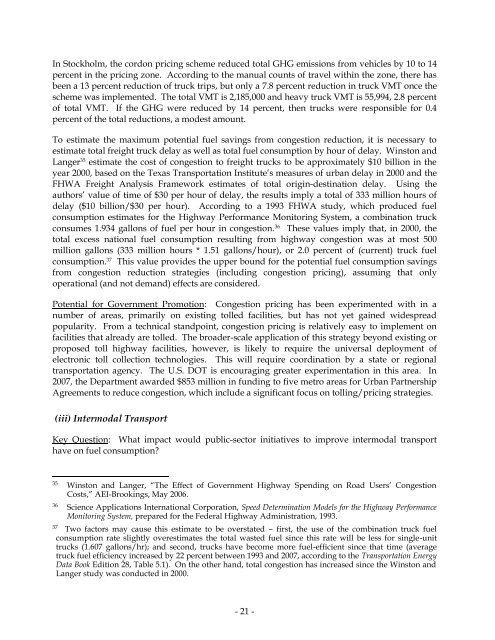Assessment of Fuel Economy Technologies for Medium and Heavy ...
Assessment of Fuel Economy Technologies for Medium and Heavy ...
Assessment of Fuel Economy Technologies for Medium and Heavy ...
Create successful ePaper yourself
Turn your PDF publications into a flip-book with our unique Google optimized e-Paper software.
In Stockholm, the cordon pricing scheme reduced total GHG emissions from vehicles by 10 to 14<br />
percent in the pricing zone. According to the manual counts <strong>of</strong> travel within the zone, there has<br />
been a 13 percent reduction <strong>of</strong> truck trips, but only a 7.8 percent reduction in truck VMT once the<br />
scheme was implemented. The total VMT is 2,185,000 <strong>and</strong> heavy truck VMT is 55,994, 2.8 percent<br />
<strong>of</strong> total VMT. If the GHG were reduced by 14 percent, then trucks were responsible <strong>for</strong> 0.4<br />
percent <strong>of</strong> the total reductions, a modest amount.<br />
To estimate the maximum potential fuel savings from congestion reduction, it is necessary to<br />
estimate total freight truck delay as well as total fuel consumption by hour <strong>of</strong> delay. Winston <strong>and</strong><br />
Langer 35 estimate the cost <strong>of</strong> congestion to freight trucks to be approximately $10 billion in the<br />
year 2000, based on the Texas Transportation Institute‘s measures <strong>of</strong> urban delay in 2000 <strong>and</strong> the<br />
FHWA Freight Analysis Framework estimates <strong>of</strong> total origin-destination delay. Using the<br />
authors‘ value <strong>of</strong> time <strong>of</strong> $30 per hour <strong>of</strong> delay, the results imply a total <strong>of</strong> 333 million hours <strong>of</strong><br />
delay ($10 billion/$30 per hour). According to a 1993 FHWA study, which produced fuel<br />
consumption estimates <strong>for</strong> the Highway Per<strong>for</strong>mance Monitoring System, a combination truck<br />
consumes 1.934 gallons <strong>of</strong> fuel per hour in congestion. 36 These values imply that, in 2000, the<br />
total excess national fuel consumption resulting from highway congestion was at most 500<br />
million gallons (333 million hours * 1.51 gallons/hour), or 2.0 percent <strong>of</strong> (current) truck fuel<br />
consumption. 37 This value provides the upper bound <strong>for</strong> the potential fuel consumption savings<br />
from congestion reduction strategies (including congestion pricing), assuming that only<br />
operational (<strong>and</strong> not dem<strong>and</strong>) effects are considered.<br />
Potential <strong>for</strong> Government Promotion: Congestion pricing has been experimented with in a<br />
number <strong>of</strong> areas, primarily on existing tolled facilities, but has not yet gained widespread<br />
popularity. From a technical st<strong>and</strong>point, congestion pricing is relatively easy to implement on<br />
facilities that already are tolled. The broader-scale application <strong>of</strong> this strategy beyond existing or<br />
proposed toll highway facilities, however, is likely to require the universal deployment <strong>of</strong><br />
electronic toll collection technologies. This will require coordination by a state or regional<br />
transportation agency. The U.S. DOT is encouraging greater experimentation in this area. In<br />
2007, the Department awarded $853 million in funding to five metro areas <strong>for</strong> Urban Partnership<br />
Agreements to reduce congestion, which include a significant focus on tolling/pricing strategies.<br />
(iii) Intermodal Transport<br />
Key Question: What impact would public-sector initiatives to improve intermodal transport<br />
have on fuel consumption<br />
35<br />
Winston <strong>and</strong> Langer, ―The Effect <strong>of</strong> Government Highway Spending on Road Users‘ Congestion<br />
Costs,‖ AEI-Brookings, May 2006.<br />
36<br />
Science Applications International Corporation, Speed Determination Models <strong>for</strong> the Highway Per<strong>for</strong>mance<br />
Monitoring System, prepared <strong>for</strong> the Federal Highway Administration, 1993.<br />
37<br />
Two factors may cause this estimate to be overstated – first, the use <strong>of</strong> the combination truck fuel<br />
consumption rate slightly overestimates the total wasted fuel since this rate will be less <strong>for</strong> single-unit<br />
trucks (1.607 gallons/hr); <strong>and</strong> second, trucks have become more fuel-efficient since that time (average<br />
truck fuel efficiency increased by 22 percent between 1993 <strong>and</strong> 2007, according to the Transportation Energy<br />
Data Book Edition 28, Table 5.1). On the other h<strong>and</strong>, total congestion has increased since the Winston <strong>and</strong><br />
Langer study was conducted in 2000.<br />
- 21 -
















